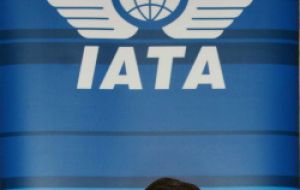MercoPress. South Atlantic News Agency
Air passengers traffic in 2009 experienced biggest decline in post-war era
 Giovanni Bisignani, IATA’s Director General and CEO expects a Spartan 2010.
Giovanni Bisignani, IATA’s Director General and CEO expects a Spartan 2010. The year 2009 saw the biggest decline in air passenger traffic in the post-war era, according to the International Air Transport Association IATA. Passenger demand for the full year was down 3.5% with an average load factor of 75.6%. Freight showed a full-year decline of 10.1% with an average load factor of 49.1%.
“In terms of demand, 2009 goes into the history books as the worst year the industry has ever seen. We have permanently lost 2.5 years of growth in passenger markets and 3.5 years of growth in the freight business,” said Giovanni Bisignani, IATA’s Director General and CEO.
International passenger capacity fell 0.7% in December 2009 while freight capacity grew 0.6% above December 2008 levels. Yields have started to improve with tighter supply-demand conditions in recent months, but they remained 5-10% down on 2008 levels.
“Revenue improvements will be at a much slower pace than the demand growth that we are starting to see. Profitability will be even slower to recover and airlines will lose an expected 5.6 billion USD in 2010,” said Bisignani.
Seasonally adjusted demand figures for December compared to November 2009 indicate a 1.6% rise in passenger traffic while freight remained basically flat with a 0.2% decline.
However in December 2009 passenger demand recorded a 4.5% improvement compared to December 2008, which is an 8.4% demand improvement from the February 2009 low point, but still 3.4% below the early 2008 peak.
Latin American carriers recorded 7.1% growth in December. Full-year traffic growth was constrained to 0.3% due to the impact of Influenza A (H1N1) fears during the second and third quarters.
“The industry starts 2010 with some enormous challenges. The worst is behind us, but it is not time to celebrate. Adjusting to 2.5-3.5 years of lost growth means that airlines face another Spartan year focused on matching capacity carefully to demand and controlling costs,” said Bisignani.
“We also face a renewed challenge on security as a result of the events of 25 December 2009. The approach of the Obama administration is encouraging with Department of Homeland Security Secretary Janet Napolitano visiting IATA’s offices in Geneva to engage industry to find solutions. We agreed that governments and industry must cooperate and we are preparing for a meeting in the coming weeks to follow-up on our recommendations which focused on finding more efficient ways to implement intelligence-driven and risk-based security measures,” said Bisignani.
“Governments and industry are aligned in the priority that we place on security. But the cost of security is also an issue. Globally, airlines spend 5.9 billion USD a year on what are essentially measures concerned with national security. This is the responsibility of governments, and they should be picking up the bill,” said Bisignani.




Top Comments
Disclaimer & comment rulesCommenting for this story is now closed.
If you have a Facebook account, become a fan and comment on our Facebook Page!